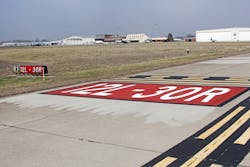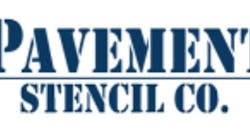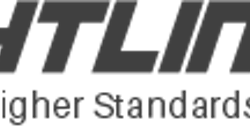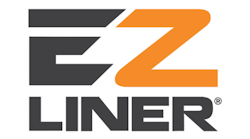St. Louis Downtown Airport (CPS) in Cahokia, Ill., repainted all its runway intersections for a new enhanced centerline painting scheme in 2019. All surface painted signs were obliterated and replaced, and two intersections were completely relocated away from the runway, requiring more obliteration and painting.
The project was planned with the Illinois Department of Transportation (IDOT) for state funding to bring all the markings current with Advisory Circular 150/5340-1M
Specifically, the airport had to address the size and dimensions of surface painted signs, which are different depending on the width of the taxiway; the requirements for the number of surface painted signs per intersection; and the reflective beads that are embedded in the paint.
The project was bid with professional painters because existing paint proved difficult for the airport staff to remove while meeting FAA standards. This approach helped to save time and allowed for the project to be completed faster.
“We value the collaborative partnership with IDOT and the FAA for funding of this project, which brings us into compliance with the latest standards and enables our airport to continue to meet the needs of our users and the industry,” said Mary Lamie, executive vice president – multi modal enterprises for Bi-State Development, which owns and operates St. Louis Downtown Airport.
Big Changes in Painting
Airfield marking standards have changed drastically in the past year. The FAA implemented a minimum reflectivity standard in December 2018 and in May, it released a set of rules that included language saying how workers involved in airfield markings should be trained.
Mike Speidel, vice president of Sightline Inc., said his company gave a presentation to FAA inspectors two years ago and about half of those in attendance noted a gap in training for workers applying markings.
Specifically, inspectors saw issues with glass bead distribution and application.
“Since I’ve been around, I’ve seen a lot of different marking configurations added and more markings don’t necessarily increase situational awareness,” Speidel said. “If it’s not applied well, those markings are essentially useless.”
Airports have traditionally used striping equipment meant for parking lots and roads due to a lack of options on the market. Some airfield-specific equipment has become available in recent years, which can include pressurized bead dispensing systems properly mounted to equipment. Speidel said you need something that will provide both performance and durability.
“You have to have the right tool for the job,” Speidel said. “You can train all day, but if you don’t have something that’s going to be able to produce what you’re trying to get out of it, it’s just a battle.”
Speidel said training programs need to talk about standards. There are a lot of airports with markings in the wrong place or using the wrong marking patterns and they’re not even aware of it.
“The course needs to be from design to line,” he said. “You don’t just start talking about paint and how to put it down. It really needs to start from a project design aspect because so many issues we see in the field can be mitigated if you have a good design.”
Sightline developed a program called the Airfield Marking Professional (AMP) in anticipation of the new training regulation.
The FAA introduced a new regulation in 2019 under AC5340-1M, stating all surface markings painted with stencils can’t leave gaps. Airports also can’t hand paint the gaps either because the painting where the stencil bridge will not be congruent if glass beads are hand thrown on the hand painted areas.
Beth Bell, owner of Pavement Stencil Co., said they designed a new stencil template with a raised bridge to allow paint and beads to eliminate the need for going back to paint again. The painting machine runs over the stencil, but the space allows the paint and beads to roll under the bridges.
“Every time we’ve met with airfield guys or contractors they will always say ‘golly, I wish we didn’t have to have the breaks in there and you could do something about it,’” she said. “Now there are a number of airports out there using them.”
Charlotte-Douglas International Airport (CLT) tested the product for the company, Bell said. They demonstrated it at the Tulsa International Airport in 2019.
They’re now being used at airports like Los Angeles International Airport (LAX), Boston Logan International Airport (BOS) Pittsburgh International Airport (PIT), CLT and Winnipeg International Airport (YWG).
“It’s important for safety and it saves them time, money and energy,” she said.
Bell said there isn’t a need for additional training either. The stencil works the same as a traditional unit so they paint in the same fashion.
Look at Equipment Options
Denny Tooker, director of sales and marketing for EZ-Liner, said there are a lot of different options available for airports when it comes to striping equipment, especially when it comes to technology. Depending on the budget, it’s not necessary to have the most advanced equipment to get the job done.
Airports can opt for skip timers while a lot of them are still using shingles at the end of a paint line to get a crisp cutoff.
“A lot of them just want to keep it simple if they’re not painting a lot,” said Norm Scholten, truck project manager for EZ-Liner. “Some of them just use on/off switches to run the guns, they don’t have a fancy operator cab, just a canopy.
An airport investing in new airfield technology may consider Waterblasting to meet its needs.
Adam Baldwin, vice president of marketing for Hog Technologies, said waterblasting allows airports to remove paint without causing the excessive environmental impact caused by traditional chemical removal methods. One machine uses and recaptures water to remove paint and rubber.
Traditional chemical removal is expensive, takes several machines and all the debris runs off into the grass area, creating environmental issues.
“It’s so much more versatile than cleaning up rubber on the runways,” Baldwin said. “It can also rejuvenate the pavement and paint markings around the airport.”
Using a waterblaster to clean lines shows an airport it doesn’t always have to repaint markings. Michael Lettengarver, senior director of North American sales for Hog Technologies, said some airports use them daily to clean surfaces.
Lettengarver said Hog’s technology can remove rubber from the centerline without damaging the paint.
“Every airport that owns a waterblaster like ours does more cleaning than anything,” Lettengarver said.
Waterblasting also cleans the airfield surface before the application of paint. This ensures paint won’t flake because it was laid on top of foreign substances.
“On concrete, you need to remove the curing compound before you apply the paint,” Lettengarver said. “There’s a lot of people who don’t do that and again, the same results of flaking and chipping.”
Hog is releasing its new Surface Hog soon. It’s smaller than current units and uses about 7,000 PSI to clean around the airfield. It provides a versatile tool for cleaning around all the terminals.
The new Hog Tusk Waterblasting head is equipped with grinder teeth. It rotates at 2,400 RPM, and the teeth only touch the material, not the surface of the runway. It allows easier centerline removal while still using Waterblasting. It uses half the water and goes five times the speed.
In one demonstration, the Hog Tusk was able to remove 120 MIL of thermoplastic at a pace of 236 feet per minute, compared to about 40 feet per minute with a traditional head.
“You can go over the marking with one blasting head at five to six times the speed of a regular water blaster and profile it with the grinding teeth and the water blaster cleans it up to leave a smooth, clean Waterblasting profile,” Lettengarver said.
Hog performs an extensive training program for its equipment. The airport can train its top operators and technicians on the equipment usage and maintenance during a four nine-hour days. All the training is on-site to ensure operators are learning how to use it in their own environment.
Scholten said airports need to determine its tolerance for investing in new equipment and weigh the cost with maintenance and downtime of current equipment. Escalating maintenance costs could indicate it’s more economical to invest in something new.
“It’s really based on how well they take care of the equipment,” Tooker said. “The equipment can run forever, but if they don’t do a lot of maintenance on it, then it’s like if you don’t fix the brakes on your car. You just don’t want to use it anymore.”
Know Your Needs
Laughlin/Bullhead International Airport (IFP) in Bullhead City, Ariz., has passed four straight Part 139 inspections.
With its location in the southwest, IFP is subject to five straight months of 100-plus degree temperatures. It’s also located within the Colorado River Basin, making it a very windy environment as well, which can be challenging to find days to address paint.
“We put a tremendous amount of care into painting,” Jeremy Keating, airport director for IFP said. “I learned in my career that you have to watch anyone who is painting like a hawk. It’s almost to the point that you have to micromanage.”
IFP uses inhouse staff for some of its smaller painting needs. For example, the airport purchased equipment to allow staff to handle issues with lead-on/lead-off lines. Contractors with long line trucks are brought in for more complex issues.
IFP utilizes test strips to make sure crews are using correct colors and nozzles are performing properly. Strips are laid on far flung areas of the airfield to test overall quality before crews lay down paint.
“We have small pieces of ride on and push pieces of equipment and we rely on the long line trucks to do other heavy duty lifting of the longer lines that need to be straight,” Keating said.
Grove City Regional Airport (GMJ) in Grove, Okla., is rehabilitating its east side taxiways and runway pavement and lighting program.
The $3.2 million program includes the installation of all new pavement and striping. The airport will go out to bid in October and construction is expected to begin in 2021. The entire program should be completed by 2023.
Lisa Jewett, airport manager, said it was 20 years since anything other than crack sealing was done to the runway. The east side taxiway has also undergone crack sealing, but the airport is starting to see alligator cracking.
“Right now we just want something that’s nice,” she said. “We’re getting bigger and bigger jets every single year and we’re making sure we can handle that and we’re going to continue to keep our runway into a condition that can handle these bigger jets.”
The FAA and Oklahoma Aeronautic Commission does regular inspections of the airfield, Jewett said, and current painting and striping are listed in fair condition, which means the numbers and lines are quite faded.
“We know what we need to address out there, but they will come and make sure you’re addressing those issues to make sure your pavement is safe,” Jewett said.
Speidel said airports need to look at who does the striping work, what tools are they using and how they’re approaching painting.
“Is your culture pretty set on the way things have always be done? Do you repaint everything every year irrespective of need?” he asked.
Speidel recommends airports start tracking paint and stripes like an asset. If you have an asset management program for signs and lights markings need to be part of that program. Know where they are and how they wear so you can mitigate issues proactively.
“When it gets to the point its really thick or peeling up, that’s when it’s too late to do something easy,” he said. “That means total replacement, total removal and that’s the most expensive activity.”
Speidel said there’s still a challenge with the minimum reflectivity standard. While the FAA has put forth a measurable tolerance, there are inspectors using a subjective eye test. A proactive approach means airports can have objective information to present to an inspector who may present a subjective opinion.
“A lot of proactive airports understand if they measure, they can determine what not to paint,” Speidel said. “My job is to tell you what not to paint. We want to reduce the amount of paint that goes down and the amount of labor it takes to put it down.
“Our goal is to save time and money at the same time.”
Airports need to understand what options are available to them to lower costs.
Keating said staff are cognizant of the current FAA regulations and each time a new advisory circular is issued it’s made available in print or via an iPad to share with them or contractors when performing work. Contractors are also required to stay until nightfall when painting to ensure a minimum reflectivity test can take place.
Keating said IFP paints when it needs to, but given it’s an airport authority, it relies on consultants for a lot of work.
“We don’t have the luxury of reaching out to the city’s public works department, who has a bunch of machines and all you need to do is escort them to where they need to paint,” he said. “These machines save us a lot of money by not having to call contractors out here for everything.”
Bell said workers can lessen painting costs by using inserts. When painting red boxes, often the white lettering still meets reflectivity requirements, so an insert allows workers to repaint the red while sparing the existing white paint.
Sometimes you see people repainting when they don’t need to,” she said. “Sometimes if they just clean the markings, they don’t have to repaint and that’s helpful over time because it’s less costly to the airport.
Bell also said airports need to be painting with a machine. Painting by hand isn’t a best practice.
“Best practices are about safety. While markings are sometimes the last thing to go down, they’re vital to pilot safety and anyone on the airfield,” she said. “These are highly expensive projects, but when it comes to doing markings on the airfield, stencils are probably the least expensive way to make sure the airfield is safe.”
Airports need to make sure stencils are made to FAA spec for the size of the airport. You should also consider it a quality product.







